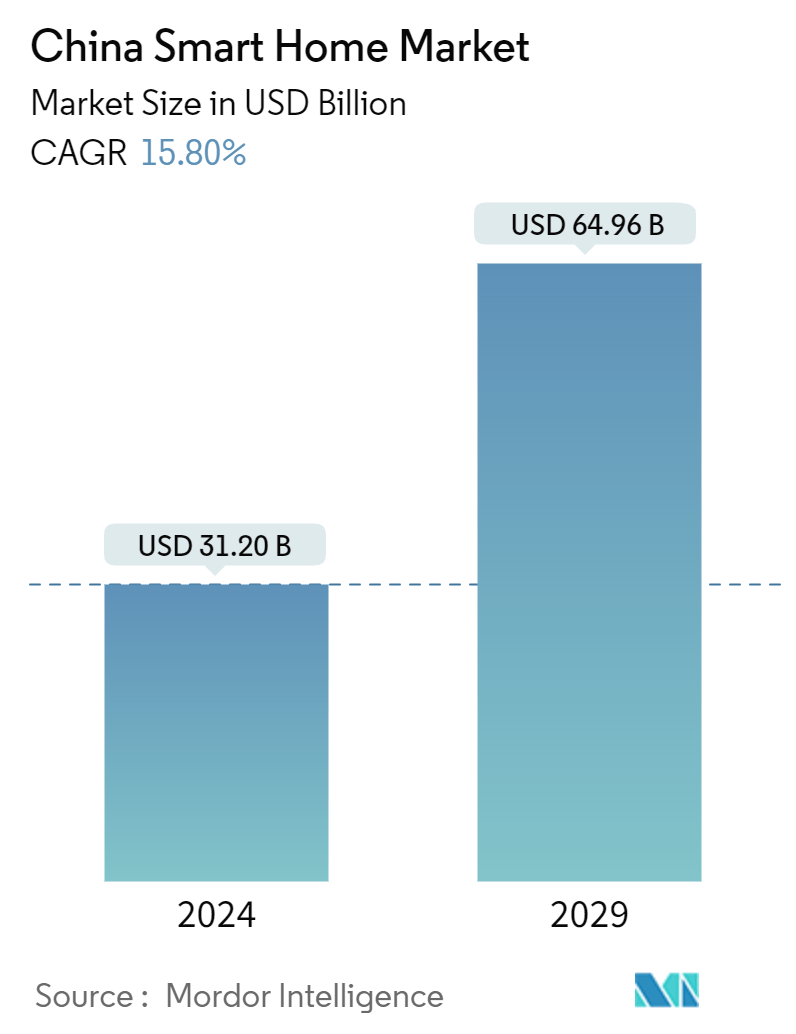Market Size of China Smart Home Industry

| Study Period | 2019 - 2029 |
| Base Year For Estimation | 2023 |
| Market Size (2024) | USD 31.20 Billion |
| Market Size (2029) | USD 64.96 Billion |
| CAGR (2024 - 2029) | 15.80 % |
| Market Concentration | Low |
Major Players
*Disclaimer: Major Players sorted in no particular order |
China Smart Home Market Analysis
The China Smart Home Market size is estimated at USD 31.20 billion in 2024, and is expected to reach USD 64.96 billion by 2029, growing at a CAGR of 15.80% during the forecast period (2024-2029).
- Chinese consumers are increasingly familiar with the term 'smart home' as many smart devices flood the market, and brands emphasize 'smartness' in their home appliances. Leveraging public-private partnerships and targeted technological innovations, China has successfully rolled out smart city infrastructure in many major metropolises, extending its reach into the residential sector.
- Shifting from an export-driven to a consumption-centric economy, China is pivoting toward energy efficiency while not facing notably high energy costs. The government, recognizing the significance of energy and water conservation, is actively promoting smart home technologies that optimize resource usage.
- Advancements in sensor technology have led to innovations like sensor-embedded insulation and 'smart mirrors' capable of monitoring skin conditions. Beyond the novelty, the ability of these new sensors to process data locally is poised to hasten the widespread adoption of smart home technologies.
- While Western smart cities often adopt a grassroots approach, China's strategy is predominantly top-down, with the central government leading. A notable example is the joint issuance of guidelines at the beginning of 2022 by 16 government departments, including the Ministry of Housing and Urban-Rural Development and the Ministry of Public Security. These guidelines laid out policies, systems, and standards for digital homes.
- China's tech behemoths, including Alibaba, Tencent, Didi Chuxing, Baidu, and Huawei, are pivotal in the nation's drive to modernize its city infrastructures. Their concerted efforts align with China's overarching ambition of smart city development, further bolstering the prospects of the smart home market in China.
- Furthermore, in June 2023, Xiaomi announced a new MIJIA smart home appliance in the Chinese market. The new MIJIA Intelligent Multipurpose Oven with a steamer is built to offer multiple cooking methods in a single package.
China Smart Home Industry Segmentation
A smart home refers to a set of integrated and networked devices that automate different functions within a home and can communicate both with each other and with a centralized control interface. The prominent purpose of this type of system is to enhance comfort, safety, energy efficiency, and management of household resources.
The Chinese smart home market is segmented by product type (comfort and lighting, control and connectivity, energy management, home entertainment, security, smart appliances, and HVAC control) and technology (Wi-Fi, Bluetooth, and other technologies). The report offers the market sizes and forecasts for all the above segments in value (USD).
| By Product Type | |
| Comfort and Lighting | |
| Control and Connectivity | |
| Energy Management | |
| Home Entertainment | |
| Security | |
| Smart Appliances | |
| HVAC Control |
| By Technology | |
| Wi-Fi | |
| Bluetooth | |
| Other Technologies |
China Smart Home Market Size Summary
The China smart home market is experiencing significant growth, driven by increasing consumer familiarity with smart devices and the government's strategic push towards smart city infrastructure. This shift is part of China's broader transition from an export-driven to a consumption-centric economy, emphasizing energy efficiency and resource optimization. The government's top-down approach, supported by guidelines from multiple ministries, is fostering the adoption of smart home technologies. Major tech companies like Alibaba, Tencent, and Huawei are playing crucial roles in this transformation, aligning their efforts with national ambitions for smart city development. Innovations in sensor technology, such as smart mirrors and sensor-embedded insulation, are further propelling the market, making smart home solutions more appealing and accessible to consumers.
The market landscape is characterized by a mix of small and large players, with significant contributions from companies like Schneider Electric, Emerson Electric, ABB, Honeywell, and Siemens. These companies are expanding their market presence through collaborations, acquisitions, and the introduction of new products. The demand for energy-efficient solutions, particularly smart LED lighting, is on the rise, reflecting a broader trend towards sustainability in urban residential settings. The market's growth is also supported by the increasing penetration of 5G technology and the widespread adoption of digital payment systems like Alipay and WeChat Pay, which facilitate the integration of smart home devices. As digitization deepens, the smart home market in China is poised for sustained expansion, with ongoing innovations and strategic partnerships shaping its future trajectory.
China Smart Home Market Size - Table of Contents
-
1. MARKET INSIGHTS
-
1.1 Market Overview
-
1.2 Industry Value Chain Analysis
-
1.3 Industry Attractiveness - Porter's Five Forces Analysis
-
1.3.1 Bargaining Power of Suppliers
-
1.3.2 Bargaining Power of Consumers
-
1.3.3 Threat of New Entrants
-
1.3.4 Threat of Substitute Products
-
1.3.5 Intensity of Competitive Rivalry
-
-
1.4 Technology Snapshot
-
1.5 Impact of COVID-19 Aftereffects and Other Macroeconomic Factors on the Market
-
-
2. MARKET SEGMENTATION
-
2.1 By Product Type
-
2.1.1 Comfort and Lighting
-
2.1.2 Control and Connectivity
-
2.1.3 Energy Management
-
2.1.4 Home Entertainment
-
2.1.5 Security
-
2.1.6 Smart Appliances
-
2.1.7 HVAC Control
-
-
2.2 By Technology
-
2.2.1 Wi-Fi
-
2.2.2 Bluetooth
-
2.2.3 Other Technologies
-
-
China Smart Home Market Size FAQs
How big is the China Smart Home Market?
The China Smart Home Market size is expected to reach USD 31.20 billion in 2024 and grow at a CAGR of 15.80% to reach USD 64.96 billion by 2029.
What is the current China Smart Home Market size?
In 2024, the China Smart Home Market size is expected to reach USD 31.20 billion.

